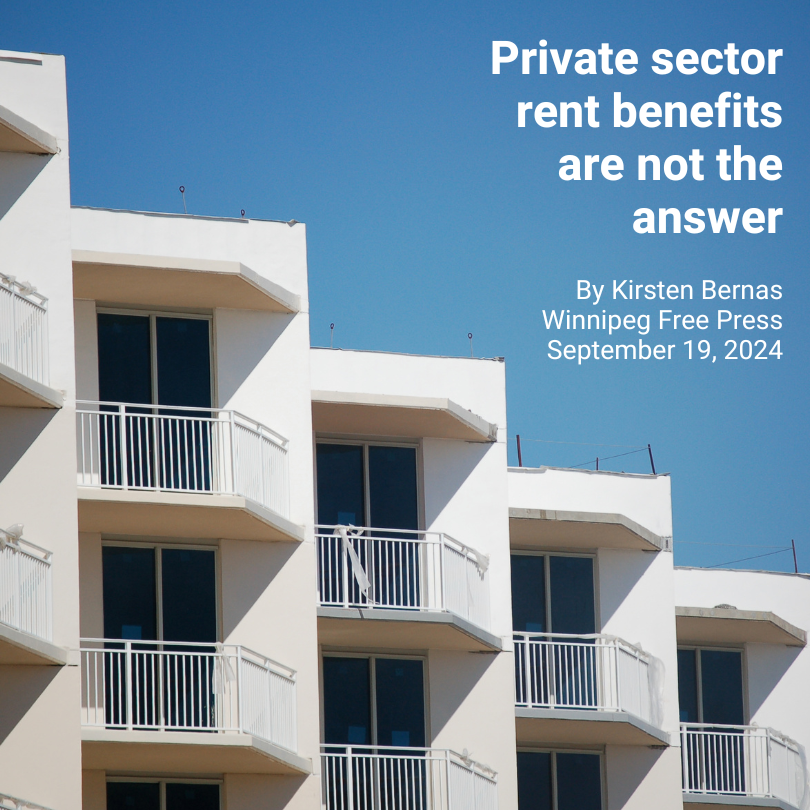
By Kirsten Bernas,
Previously published in the Winnipeg Free Press September 19, 2024
THE crisis caused by the recent pause in the Canada Manitoba Housing Benefit (CMHB) demonstrates the volatility of income subsidies as a solution for housing insecurity and homelessness. Housing advocates want governments to quit relying on private sector focused rent benefits, and instead prioritize investments in long-term public assets through the development and maintenance of social housing.
More than 400 households are at risk of eviction and homelessness due to the pause to the homelessness and youth streams of the CMHB program. The program provides eligible low-income renters with a top-up of up to $422 per month to pay rent and utilities in private market housing. Renters must have a signed tenancy agreement when they apply.
This means the tenancies of the 400-plus households who applied to the program since the pause began on Aug. 3 are now at risk. These applicants were either recently approved for housing based on an understanding that they would receive the top-up, or they were already housed and needed the top-up to maintain their tenancy because of a decrease in income.
The province attributes the pause to “unprecedented demand” and the program being “fully subscribed.” It is now exploring potential options for additional funding “to ensure no one loses their housing.”
The CMHB is funded through an agreement signed by the provincial Conservative government and the federal government under the National Housing Strategy in 2020. The federal Liberal government entered into similar agreements with every province and territory. Approximately 300,000 households were expected to receive a housing benefit by 2027/28.
Concerned advocates across Canada have been asking what will happen to the 300,000 households who rely on the monthly benefit when the strategy and funding comes to an end in 2028. We are currently witnessing the answer in Manitoba. Unless governments renew the funding, renters will face arrears, evictions, and homelessness. There is growing concern that this day may arrive sooner if there is a change in government and political will after the next federal election.
Given the severe shortage of social housing, low-income renters must look for housing in the private market and rent benefits are critical to securing that housing. But advocates continue to call out governments for relying on rent benefits and other market-led solutions to the housing crisis faced by low-income renters, as this approach comes with a number of challenges.
While they may be sympathetic to low-income renters, private market housing providers are largely motivated by profit. As private market rents continue to rise to achieve profit margins, so do the public costs of providing rent benefits.
Manitoba’s CMHB program budget was set to increase from $3.8M in 2020 to $16.9M in 2027. Another issue is that when rent regulations are poorly monitored and enforced, as they are in Manitoba, some landlords illegally increase rents to match the benefits renters are eligible for.
While the majority of property managers provide good service, others exploit the most vulnerable when tenant protections are weak, taking full advantage of government benefits without sufficiently maintaining their units.
It is no surprise that private sector landlords have been vocal proponents for the expansion of rent benefits. While presented as a policy tool that enables tenants to afford housing, rent benefits provide a public subsidy to private landlords with no accountability.
Relying on this mechanism alone is not only costly, it also generates relatively little long-term public value.
For these reasons, advocates are calling for a greater focus on expanding and maintaining the supply of publicly-owned housing. While this approach also requires significant public investments, it at least results in long-term public assets. Governments can benefit over the longterm from increases in the value of these assets and access the equity for other initiatives that generate public value.
This approach also gives governments a greater ability to ensure housing meets the unique needs of low-income renters. For example, governments can expand public housing through partnerships with non-profit organizations that serve specific populations. These partnerships can ensure low-income renters have access to housing with the social programs and supports needed to maintain their tenancies.
Finally, rent benefit programs in particular leave renters vulnerable to changes in political will. A sudden pause or end to investments results in immediate and drastic impacts on housing security. While investments in expanding and maintaining social housing are not immune to changes in political will, the immediate impacts are far less severe.
Since the National Housing Strategy launched in 2017, Manitoba created only 253 new social housing units with rents set at less than 30 per cent of household income. In 2023, the Right to Housing coalition identified the need to add 10,000 units over 10 years. The NDP government committed to 350 new units in Budget 2024.
Moving forward it must set a long-term target and timeline for new social housing units as part of a comprehensive and sustainable solution to housing insecurity and homelessness.
Kirsten Bernas is the chair of the provincial working group of the Right to Housing coalition.


